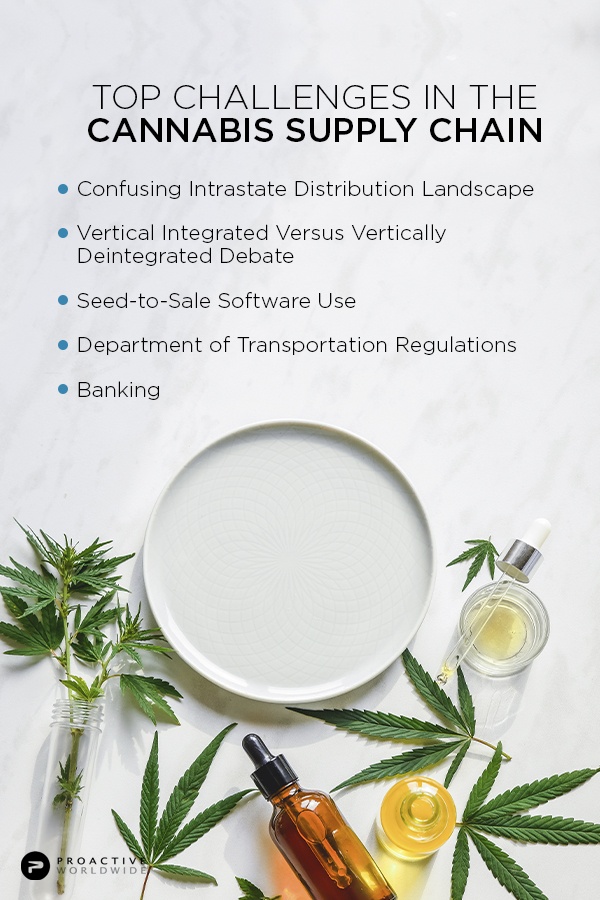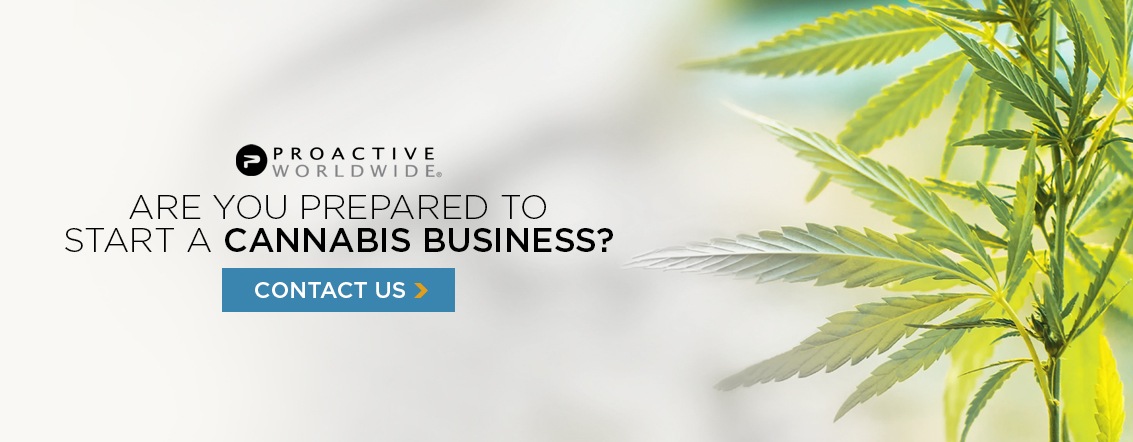Published: March 17, 2020
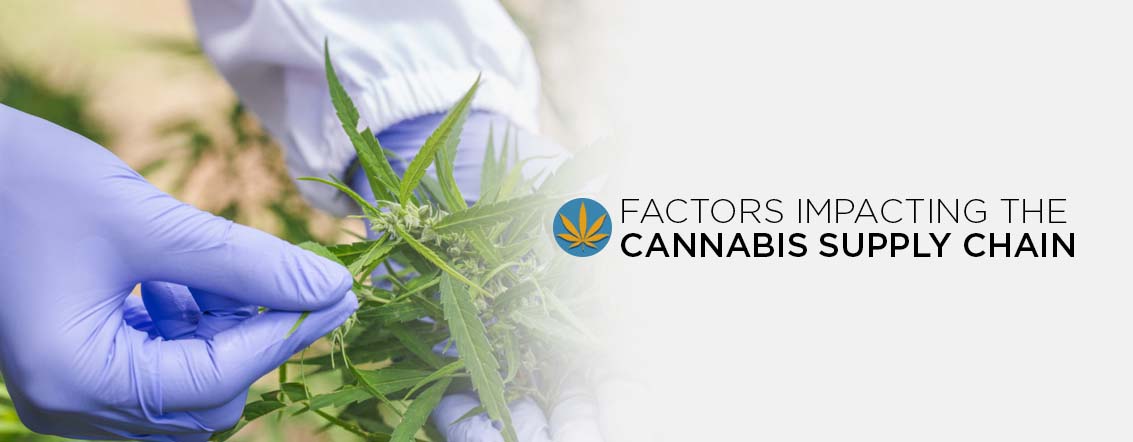
Anyone wondering how to start a cannabis business must be prepared to
handle the supply chain intricacies of this industry.
To begin, current regulations bar the transportation of marijuana across
state lines. This is a substantial inhibitor to entering or investing in
the legal marijuana space. Any supply chaing is further complicated by
additional regulations surrounding product testing, approvals, taxation and
more.
Yet cannabis business opportunities abound, with commercial purveyors
optimistic despite these hurdles.
Legally selling cannabis and cannabis-related products requires
forethought, strategy and business savvy to navigate the industry’s
ever-evolving regulations, medical and recreational uses, product testing,
safety, distribution, tax environment and more. When creating a cannabis
business plan, business owners and investors must consider these key
industry factors to find a way toward a legally established, streamlined
cannabis supply chain — and true “seed to sale” profits.
The Cannabis Business Case
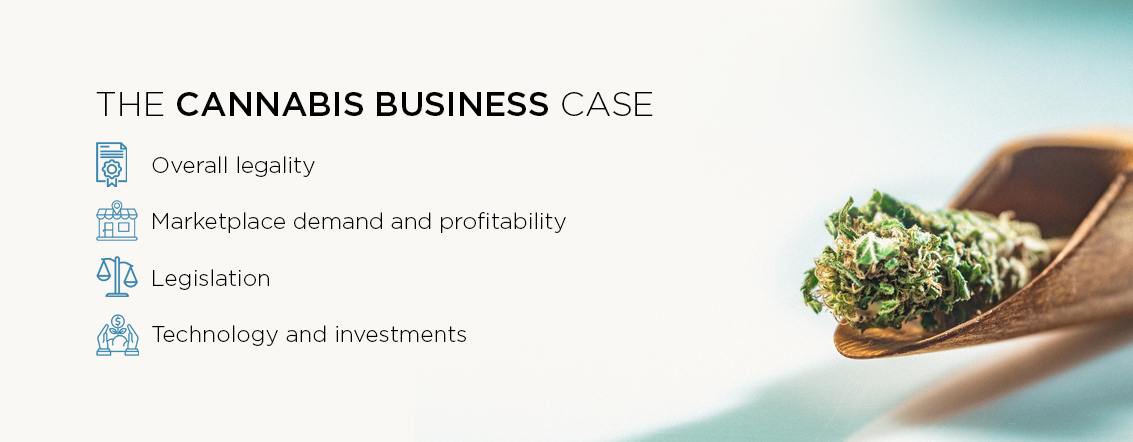
Marijuana-related businesses (MRBs) sit at an inflection point. Never in
history has the industry been poised for such commercial explosion — with
data backing up its burgeoning positioning.
- Overall legality: Over 33 states as well as Washington, D.C., permit marijuana for medical use, with a handful maintaining THC caps for medical marijuana products. In addition, 11 states as well as Washington, D.C., permit marijuana for recreational purposes.
- Marketplace demand and profitability: An estimated
38.4 million Americans consume cannabis, with over half of cannabis users reporting a consumption minimum of once a week. The projected compound annual growth rate (CAGR) of 14% for the industry reflects this enthusiastic marketplace. By 2025, experts expect the cannabis industry to surpass $30 billion in revenue, with adult-use recreational sales ballooning to account for more than half, or $16.6 billion, of that total. - Legislation: Dozens of cannabis and MRB bills currently await sessions at state and federal levels. Such legislation reform spans numerous policy topics, from decriminalizing possession and reducing marijuana-related sentencing to widening recreational usage and easing cannabis-business-owning regulations.
- Technology and investments: One of the largest shifts in the entire cannabis supply chain has been along its peripheral profile — namely those ancillary organizations and entities that do not grow and produce cannabis yet are instrumental to the industry’s survival. Investment opportunities in this auxiliary vertical space are profound. These
include everything from financial apps addressing current MRB money-management pain points to streamlined software making registration, licensing and product tracing easier for growers and
retailers alike.
An accurate exploration of a cannabis business case for investors and
business owners must unravel all this interdependent industry information,
sorting market hype from structural developments and sound business
logistics. Understanding the barriers within your state’s permitted
cannabis supply chain is the first step to building a successful and
legally viable marijuana business plan. Next, we cover more details about
these barriers, plus which look most poised for evolution.
The Current Cannabis Supply Chain
Before detailing the key challenges to overcome for a successful cannabis
business case, let’s first review the vital players in today’s established
cannabis supply chain.
1. Major Players in the “Seed to Sale” Process
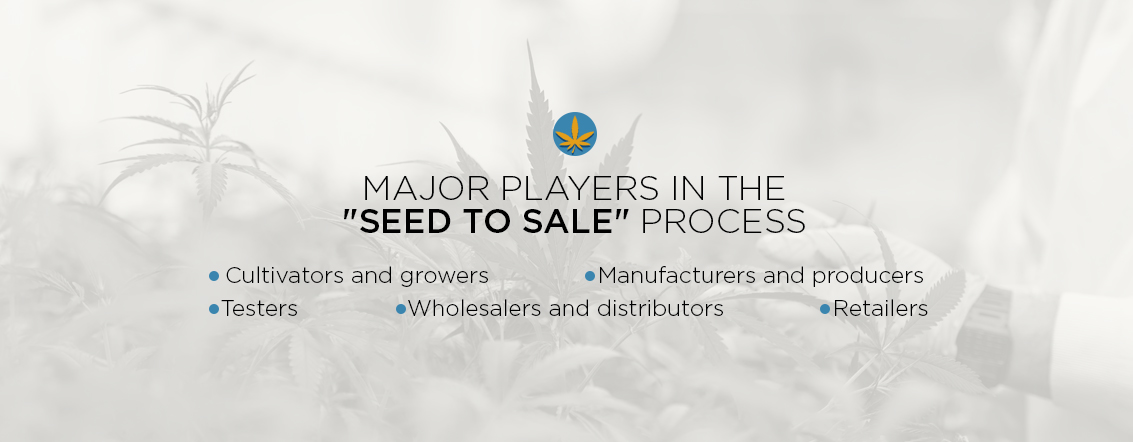
“Seed to sale” is industry-speak for the entire process of moving
marijuana-based products to sale, from planting and growing buds to their
trimming, drying, testing and distribution to partner retail dispensaries
across your state.
At each stage of seed-to-sale production sits a vendor responsible for a
unique aspect of the cannabis supply chain.
- Cultivators and growers: Commercial cannabis growers must plant, grow
and harvest their crops within their operating state. Growers are
licensed by their home state and can operate greenhouses indoors or
out, follow orchestrated harvest schedules, and employ skilled
horticulturists to monitor cannabis plant health, quality and
maturation. - Manufacturers and producers: Manufacturers and producers operate at the
next rung of the supply chain and work to trim, dry and cure cannabis
flowers into a range of final retail products. Working inside
specialized facilities, manufacturers produce everything from
traditional bud cannabis to extractions, tinctures, oils, vaporizers,
edibles and concentrates. In some supply chains, growers may produce
their own finished products, though many choose to partner with
specialized manufacturers to transform cannabis from its raw to retail
state. - Testers: Cannabis is tested in two stages within its supply chain:
first, immediately post-harvest where batches are assigned ID tags and
logged into a state’s cannabis seed-to-sale system. Second, any
transformed products, such as edibles, must additionally be tested post
modification using a sample batch. Test results log several variables,
namely the levels of residual pesticides, foreign substances and, in
some states, THC content. - Wholesalers and distributors: Wholesalers buy finish cannabis products
in bulk before selling it to licensed retailers and dispensaries. In
many partnerships, these third-party distributors must test and package
products themselves while orchestrating state-wide distribution that
connects growers and producers with commercial retail outlets. For this
reason, wholesalers and distributors often manage the most
transportation regulations and compliance hurdles in the entire,
traditional marijuana supply chain — though licensing mandates vary by
state. - Retailers: More commonly known as dispensaries, retailers purchase
unbranded or white-labeled finished marijuana products to sell in their
own places of business. Cannabis retailers frequently design and
purchase their own proprietary packaging for marijuana products,
helping brand their goods and differentiate from the competition. It is
more common for small- and medium-sized dispensaries to participate in
white labeling rather than growing, trimming, drying and producing
their own complete line of marijuana, further reinforcing the need to
understand the wider cannabis supply chain.
2. Ancillary Versus Direct Cannabis Businesses
Ancillary versus direct, or plant-touching, marijuana ventures are a second
supply chain variable to note when entering the MRB space.
- Plant-touching MRBs: As the name suggests, a plant-touching MRB
directly handles marijuana plants, flowers and finished products. This
category of supply chain players includes growers, wholesalers and
commercial dispensaries. - Ancillary MRBs: Ancillary MRBs include a broader category of supply
chain partners that don’t directly grow or produce cannabis itself, but
instead manufacture products responsible for growing and selling
successful cannabis harvests. Cautious entrepreneurs, startups and
investors may find starting or funding ancillary MRBs a more attractive
choice due to the product handling buffer. In fact, many large funds
and investment vehicles still restrict investing directly in
plant-touching operations, at times limiting the funding and capital
opportunities of those who grow, move and distribute cannabis goods
directly.
Examples of cannabis businesses in an ancillary vertical include:
- Industry-specific growing, testing and sales software
- Greenhouse lighting, such as high- and low-bay fixtures, heat lamps and
indoor and outdoor LEDs - Greenhouse infrastructure and equipment, including commercial-grade
HVAC and environmental control systems, hydroponics, irrigation,
drainage, watering and generators - Fertilizers, injectors, soil mixers and stabilizers
- State-licensed testing facilities and lab equipment
- Third-party packaging companies specializing in cannabis products
- And more, depending on your home state
Top Challenges in the Cannabis Supply Chain
The largest functional barrier in the end-to-end cannabis supply chain
remains the illegality of its interstate movement.
Yet current and future business owners looking to capitalize on the Green
Rush have several other major factors to weight even when establishing legal cannabis distribution networks within the same state’s boundaries.
1. Confusing Intrastate Distribution Landscape
The state-by-state subjectivity of cannabis production and retailing means legal distribution channels will vary depending on your company’s home state.
For example, permitted distribution options for direct, plant-touching MRBs
might include any or none of the following:
- Independent, third-party distributors allowed in an open-market fashion
to transport cannabis products between all supply chain players. - A handful of state-approved distributors certified to transport
cannabis products between all supply chain players. - State-approved cannabis warehouses on behalf of growers and
wholesalers. - Pre-approved versus free-market packaging and shipping compliance for
growers and wholesalers. - Compliant storage and transportation of cannabis products between
testing stages. - Specific business licenses required before general, third-party
transportation companies can participate in shipping and moving
cannabis. - Individually applied for and permitted business licenses for cannabis
producers and cooperatives to transport their products within state
boundaries.
As illustrated, the flow of seed-to-sale cannabis is state-specific,
multifaceted and ultimately bureaucratically governed. Further complicating
matters is the fact that growers, wholesalers and retailers themselves may
face different distribution restrictions. Again, these network rules are
contingent primarily on the state where your business is based, as well as
the type of supply chain operations you wish to take on.
2. Vertical Integrated Versus Vertically Deintegrated Debate
Currently, many states’ cannabis industry runs on some form of a vertically
integrated supply chain.
In this design, MRBs are encouraged — if not required — to hold multiple
licenses across major phases of the marijuana supply chain. For example, in
Massachusetts, where vertical integration is required for cannabis
businesses, organizations apply for multiple licenses allowing them to
control multiple stages of their supply chain internally, from cultivation
through production and onto retailing.
In contrast, states like Washington allow MRBs to hold only one license for
one stage of the supply chain. Meanwhile, other states like Colorado and
Oregon give MRBs the choice to hold one or more supply chain licenses.
However, emerging legislation trends nationwide are proposing revamped
cannabis supply chains with deintegrated structures. Supporters of
deintegrated vertical chains herald this model’s ability to open up the
industry for more players, competition and — ultimately — consumer access,
propelling that state’s cannabis market to new profits.
This complicated debate between economic opportunity and government
oversight strikes at many core issues when starting a cannabis business
supply chain — applying and receiving the right license, for the right
supply chain operation, at the right time, all while emerging deintegration
policies loom. Since each state maintains their own licensing and
license-oversight systems, it’s that much more difficult to come up with a
streamlined cannabis supply chain or to outline macro policies harmonizing
the supply chain as cannabis legislation continues to garner attention at
the federal level.
3. Seed-to-Sale Software Use
States that have legalized medical or recreational cannabis rely on
seed-to-sales software databases. All growers, processors, testing labs,
wholesalers and retailers are required to use these databases.
They are extensive, logging unique IDs for every cannabis harvest from
every licensed grower. In addition to compiling all legal cannabis
cultivation, government seed-to-sale software also logs:
- Lab test results for pesticides and contaminants after harvest and
production phases - Processing IDs categorizing the final products made from a
single-source cannabis harvest - Distribution and transportation history from licensed or
state-approved, third-party shipping vendors - Inventory inputs from cannabis retailers and wholesalers
These seed-to-sale pieces of software are instrumental in keeping a state’s
marijuana production traceable. Every unit harvested becomes accounted for.
Yet for micro-businesses, operators and anyone new to the plant-handling
supply chain, these systems can be overwhelming at best and existentially
threatening at worse when reporting requirements are not met.
What’s more, integrating point-of-sale systems and other back-office
applications with the system can also be a functional issue, particularly
as a new retailer, wholesaler or operator. This may lead to the unintended
consequences of misreporting transactions and purchasing histories, or
all-out avoiding such systems due to their time-consuming and
interdependent supply-chain complications.
4. Department of Transportation Regulations
Any freight truck regulated by the U.S. Department of Transportation is
currently barred from transporting marijuana or marijuana-derived products.
This federal ban introduces serious supply chain hurdles surrounding
cannabis shipping and transportation. Growers and manufacturers must find
workarounds with smaller freight organizations falling outside the
Department of Transportation qualifications for oversight, typically by
placing smaller orders needing smaller vans, not trucks.
While such companies exist, many cannot provide robust service suites
larger freight fleets can. The results are security concerns regarding
cash-based shipping transactions, route protection and tracking, anti-theft
management as well as the safety and integrity of the en-route cannabis
cargo itself.
As the cannabis industry matures, it must address transportation logistics
like these even within a single state’s borders. Doing so liberates all
MRBs from relying on small-batch van shipments to more cost-effective, bulk
transportation alternatives.
5. Banking
Transportation logistics aren’t the only federal barrier hindering
cannabis-related businesses from starting legally and efficiently. Perhaps
even more convoluted are the financial hurdles entrepreneurs and investors
in MRBs must navigate — namely, the fact that FDIC-insured banks are not
allowed to conduct any business with cannabis organizations.
Without FDIC-insured banking infrastructure, MRBs must find financial
alternatives to manage a profitable business, including systems for:
- Payroll
- Sales
- Business expenses
- Vendor payments
- Tax records-keeping
- Compliance records-keeping
- And much more
Many MRBs use apps as a workaround, while others maintain all-cash
operations that generate a litany of downstream compliance headaches.
Legislation sits in the works within many cannabis-legalized states to
rectify these banking and finance issues, yet until then MRBs must balance
serious safety and documentation concerns related to managing cash across
its entire supply chain.
Are You Prepared to Start a Cannabis Business?
The current cannabis supply chain is complicated and, at times,
contentious. Yet there’s no denying the burgeoning business opportunities
innate in today’s — and tomorrow’s — Green Rush.
Those serious about starting a cannabis business must first understand the
banking restrictions uniquely affecting the cannabis market. It’s why we’ve
put together a landmark syndicated report on cannabis and banking, which
uncovers solutions to:
- The laws and regulations barring MRBs from working with routine
business banking channels - Solutions and alternative payment methods for MRBs
- Key risks and pain points involved in these alternative
money-management methods - Anti-laundering, revenue, tax and securities laws still affecting MRBs,
even without typical banking infrastructure and oversight - And much more
Download the comprehensive cannabis and banking guide to understand the risks
before they become realities and strengthen your marijuana business plan today.

